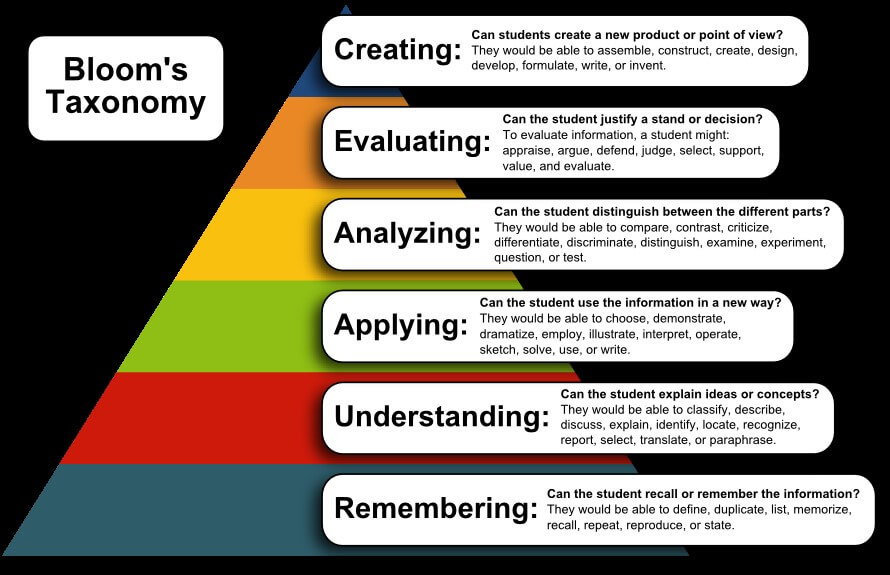
Types of NCLEX Questions and How They Are Written
As you prepare to sit for your National Council Licensure Examination (NCLEX), the last step to becoming a professional nurse, it’s important to understand what types of questions you’ll be answering on the day of your test.
You’re reading one of our “Nursing Career Guide” articles. Need to practice for your upcoming exam? Have a look at our free NCLEX practice questions -- no registration required! ✨
The questions, also called test items, are written to evaluate your knowledge, skills, and ability to provide safe care for clients. As you begin to study, the content and range of topics can seem challenging. But with practice -- and patience -- you’ll learn how to break down the questions, look for clues, and gain confidence about your answers.
Bloom’s taxonomy: The model used to write NCLEX test items
Bloom’s taxonomy is a three-part model that classifies learning objectives and skills into six levels. It’s a model similar to Maslow’s Hierarchy of Needs; each level depends on the one below it and all levels are necessary to reach the top. NCLEX uses the cognitive domain model, which is knowledge-based. There are also affective domain (emotion-based) and psychomotor domain (action-based) models.
The taxonomy has been around since 1956, when Benjamin Bloom, an educational psychologist at the University of Chicago, established six classifications of objectives and skills that could help educators design and assess learning. The taxonomy was updated in 2007 to reflect current practice:
- In order to understand an idea or process, you must first remember.
- To apply an idea or process, you will need to understand .
- Before you can evaluate an idea or process, you’ve got to analyze .
- To create new ideas and projects, you’ll perform an extensive evaluation.

Updated Bloom’s Taxonomy (2007) Reference: Courses.dcs.University of Wisconsin
All NCLEX questions are based on the cognitive domain of the taxonomy for writing and coding test items. NCSBN, the organization that oversees NCLEX, states, “Since the practice of nursing requires application of knowledge, skills and abilities, the majority of items are written at the application or higher levels of cognitive ability, which requires more complex thought processing.”
How will Bloom’s taxonomy look on the exam?
NCLEX is designed to determine if you are able to practice nursing at an entry level. You’ll be expected to use your education and clinical experience to analyze situations and apply critical thinking skills to provide safe care for clients.
Here are how the taxonomy levels might look on NCLEX questions, along with some key words that can help identify the type of question:
Remembering: Recalling information from your nursing classes. This is simple memorization. Examples: Normal vital signs or anatomical names.
Which of the following indicates hypokalemia?
- 2 mEq/L
- 6 mEq/L
- 0 mEq/L
- 4 mEq/L
Answer: 1. The normal potassium level in the blood is 3.5-5.0 milliEquivalents per liter (mEq/L). Hypokalemia is a low potassium level.
Look for these words: List, name, recall, match, define, order.
Understanding: Constructing meaning from information by interpreting, comparing, or explaining. You understand what you have remembered -- and WHY. Example: Knowing how to choose the correct needle size for an injection.
A common complication of cirrhosis of the liver is prolonged bleeding. Which vitamin is likely to be administered to alleviate this condition?
- Vitamin A
- Vitamin C
- Vitamin E
- Vitamin K
Answer: 4. Vitamin K is a fat-soluble vitamin that depends on liver function for absorption. If levels are low, the client will need to have it administered in order to produce prothrombin.
Look for these words: Describe, explain, select, identify, select, interpret.
Applying: Using previously-acquired knowledge, facts, or techniques to carry out a procedure and to solve problems in new situations. Examples: Dosage calculations, Maslow’s Hierarchy, human growth and development stages, and procedural steps.
The provider orders 1L of 0.9% NS to be infused over 8 hours. The drop factor for the tubing is 10 gtts/mL. How many gtts/min should the nurse administer?
- 5 gtts/min
- 125 gtts/min
- 21 gtts/min
- 210 gtts/min
Answer: 3. To calculate a drip rate, divide the total volume in mL by the time in minutes. Then multiply that quotient by the drop factor in gtts/mL. For this question: 1000 mL÷480 minutes = 2.08. Round up to 2.1. Then 2.1 x 10 gtts/mL=21 gtts/min. The other calculations are incorrect.
Look for these words: Calculate, solve, predict, choose, determine, perform, prepare, sequence.
Analysis: Breaking down information into its components to determine a solution or to find a cause and effect. Examples: Client teaching, recognizing symptoms of a condition, or reviewing data from a medical record.
The mental health nurse is giving a presentation at a community center on domestic/spousal abuse. Which one of the following is a risk factor?
- Having a large circle of good friends.
- Being over the age of 30.
- Witnessing domestic abuse as a child.
- Attaining a higher level of education.
Answer: 3. Risk factors for domestic/spousal abuse include: Alcohol or drug abuse; low-income or poverty level; being under age 30; an unplanned pregnancy; witnessing domestic violence as a child; history of abuse as a child; and history of abusive relationships. A higher education level and a large circle of friends reduce the risk, but do not eliminate it.
Look for these words: Examine, determine, compare, detect, calculate, categorize, investigate.
Evaluating: Coming to the best solution, based on sound criteria, evidence, or protocols. Using data from analysis, form an opinion. Example: Client status after treatment or interventions, task delegation, or verifying client teaching.
The RN on a busy pediatric unit is making shift assignments. Which patient is most appropriate for a new graduate nurse?
- A 3-year-old with hemophilia B who has suddenly become less responsive.
- A 13-year-old with sickle cell disease c/o lower right quadrant abdominal pain.
- A 7-year-old who had a T & A 2 hours ago and is now swallowing frequently.
- A 12-year-old newly diagnosed with T1D whose parents need education on insulin.
Answer: 2. A new graduate nurse can safely assess pain for a patient with sickle cell disease, as well as administer pain medication. The patient with hemophilia who has become less responsive must be assessed for a possible intracerebral bleed and prompt intervention. The post-operative patient who is swallowing frequently may be bleeding, requiring assessment by an experienced nurse. Accurate teaching about insulin is crucial, because it is “high-alert” drug that the patient’s parents must learn to manage.
Look for these words: Support, relate, contrast, justify, grade, evaluate, determine, rank.
Create: This final level of Bloom’s taxonomy isn’t part of NCLEX-PN. For NCLEX-RN candidates, it applies to learning and using all knowledge and experience to create something new. Examples: A plan of care or a quality improvement project.
A critical pathway is an important tool to manage the quality of care for a client. As part of this, variance analysis is used to recognize and intervene when a client’s care doesn’t follow the expected progress. What is the time frame for variance analysis during hospitalization?
- Continuously from admit
- Every 12 hours
- Daily during rounds
- At day of discharge
Answer: 1. A clinical pathway is a plan of care with details of the essential steps that organize and sequence the interventions for a diagnosis. Variance analysis is the difference between actual and planned behavior. Variance analysis is ongoing, from the time of admit or start of treatment, to identify and alter any events or situations that can adversely affect the outcome for the client.
Look for these words: Plan, propose, develop, modify, prepare, design, manage, specify, create.
How will these questions be presented?
For both the NCLEX-RN and NCLEX-PN, NCSBN states, “The practice of nursing requires application of knowledge, skills and abilities; therefore, the majority of items are written at the application or higher levels of cognitive ability.”
No matter the level on Bloom’s taxonomy, the test items will be one of the following formats:
Multiple Choice: About 80-90% of the questions will be standard multiple-choice questions. There is a situation or scenario that gives some information, called the “stem” of the question. Often it may include a phrase such as, “Which of the following” or “What is the most appropriate” or “What should the nurse do?” There may also be important key words, like FIRST, BEST, MOST, EXCEPT, BUT, MAY. A multiple choice question has four choices. There is always the correct answer, plus three other options, called “distractors.”
Hint: After carefully reading the stem, try to think of the answer before looking at the options. Choose the option that is the best match to what you thought of. If needed, go back to the stem and look for clues in the client’s age, diagnosis, ethnicity, or treatment.
Remember, there is ONE correct answer. Don’t overthink the question or wonder “what if.” You only have the information you’ve been given, which is sufficient to calculate what’s needed.
After a spontaneous abortion at 13 weeks’ gestation, a client reports for a follow-up at the OB/GYN clinic. The nurse observes that the client is crying. What is the nurse’s best response?
- “These things happen for a reason. The baby was probably deformed.”
- “It’s hard right now. But you’re young and will get pregnant again soon.”
- “This must be a really difficult time for you. Tell me what you’re feeling.”
- “At least you already have other children. I’m sure they are a comfort.”
Answer: 3. The nurse should not try to minimize the client’s loss. Offering platitudes, such ss having another pregnancy, show a lack of compassion. Ask the client how she is feeling and how she is coping. Observe for signs of depression and report them to the provider as indicated.
Alternate Test Item Formats
Between 10-20% of NCLEX test items will be presented in alternate formats. It’s wise to learn a little about each of them so that you’re not surprised. Although they seem different, each still covers the knowledge and experience you have now as a new graduate nurse.
Multiple-Response: These questions are similar to multiple choice, but there are four or more options, with two or more correct answers. You’re required to choose all the correct answers in order to get credit for the question. These are also called “Select all that apply” or SATA questions.
Hint: Read the stem carefully to determine what you are supposed to be looking for. Because there will be more than one correct answer, think about possibilities. For example, a SATA question might be about clinical indications of a disease, side effects of a medication, discharge instructions to a client, community education, or safety and care standards.
After you have selected all the correct responses, go back and look at the options you did not select, to be sure they are incorrect. There is no partial credit for SATA test items; they are either right or wrong.
Which of the following are signs and symptoms of a deep vein thrombosis (DVT)?
- Tenderness
- Dyspnea
- Warmth
- Hemoptysis
- Swelling
- Redness
Answers: 1,3,5,6. Deep vein thrombosis (DVT) occurs when a blood clot forms in a deep vein. These clots usually develop in the lower leg, thigh, or pelvis, but can also occur in the arm. Signs and symptoms include: Pain or tenderness, warmth, swelling, and redness. It is important to note that up to 50% of clients will not experience any symptoms. Dyspnea and hemoptysis are indications of a pulmonary embolism (PE).
Hot-Spot: These questions ask you to identify a specific type of location, such as an assessment area on the torso, an injection site, or a spot on an ECG strip. There will be a photo or diagram, with directions such as: “Identify the location…” or “Select the spot…”
After reading the question, you will place the cursor over the area you are selecting and left-click to make a red “X.” If you change your mind, move the cursor to a different spot and left-click again to erase the first “X” and create a new one.
Fill-in-the-Blank: To do a calculation like a medication dosage or IV drip rate, you will solve the problem using a calculator, a handheld device, or paper and pencil. Then you will type in your answer. The question stem will include information about measurement units, how many decimal places, and if you should round up the answer. If you do not enter a number, the computer will prompt you to “enter a numeric answer” in order to proceed.
Chart or Exhibit: In these test items, the stem is based on data from a client’s chart, often with tabs for history and physical, prescriptions, lab results, vital signs, flow sheets, and progress notes. There will be a table and tabs to present the information. Using these data, you will answer questions after locating and analyzing what’s available in the chart.
If you get a chart or exhibit question, read the information in the tables carefully. Only use the data you’re provided. Take notes on paper or on the white board that the testing center provides.
Drag-and-Drop: Also called an Ordered-Response test item, you’ll be asked to rearrange information in a specified order. For example, the question may ask the priorities for client care or the steps in a procedure. There can be up to six items. As with the Multiple-Response questions, there is no partial credit. If one item is out of place, you will not get credit.
When you sit for your NCLEX, you’ll move the items from the left side of the screen to the right side. You can rearrange them until you feel you have the correct order, then click “submit.”
Graphic Option: These are similar to Multiple Choice test items, except there are images instead of a written stem. You may see drawings, photos, or figures, with a question asking you to identify the correct response or responses. Examples are identification of a client position or a type of traction. To select your answer, simply click on the box or circle by the correct image.
Audio and/or Video Clips: For these test items, you’re asked to click a “play” button to listen to or watch a short clip, then answer a question about your interpretation. Examples of audio clips include heart sounds, breath sounds, or some type of verbal communication. Video clips might include clinical situations or procedures, such as giving an injection. With both types of clips, you can replay as often as you need.
Building Your Study Strategy
This seems like a lot of information -- and you haven’t even started to study yet! An understanding of the NCLEX process can give you a solid foundation for moving forward. When you take practice tests, you’ll know the science behind each question, as well as how to recognize exactly what the question is about.
If you missed our article on NCLEX-RN and NCLEX-PN: What to Know Before You Study, take a few minutes to read it. It covers the NCLEX categories of client needs and the distribution of the questions by percentage. It also explains the Computer Adaptive Testing (CAT) and how it will calculate your score when you sit for your exam.
To learn more about the NCSBN test plans, go to:
- NCLEX-RN Test Plan (April 1, 2019-March 31, 2022)
- NCLEX-PN Test Plan (April 1, 2020-March 31, 2023)
Find out your chances by taking one of our practice tests.
Take a free test Reviewed by
Reviewed by 

